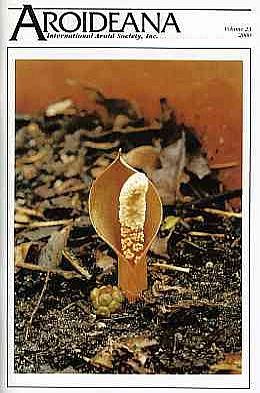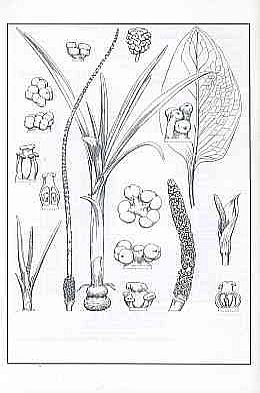|
|



Your search for articles published in volume 23 has found 13 articles.

| 
|
Articles of 3 pages or less are available for free to IAS members for download, and longer articles for $5. Articles from issues in 2016 and beyond are only available electronically, and are free to current members when they are logged in.
Please remember that all Aroideana articles are protected by copyright, and you may NOT distribute even electronic copies without permission from the authors or editor.
(Issue) |
||||
| Dewey E. Fisk | In Memoriam--Dr. Monroe R. Birdsey
This article available FREE to IAS Members with a PERSONAL login. LOGIN, REGISTER or JOIN | |||
| ABSTRACT: b. March 1922, d. January 2000 It is with deep regret to tell you about the passing of an icon. Dr. Monroe Birdsey died this last January. | ||||
| Peter C. Boyce | From the editor
This article available FREE to IAS Members with a PERSONAL login. LOGIN, REGISTER or JOIN | |||
| Josef Bogner | Friedrich Hegelmaier (1833-1906) and the Lemnaceae (Buy) | |||
| ABSTRACT: The first comprehensive monograph of Lemnaceae, the duckweeds, was written by Christof Friedrich Hegelmaier in 1868. The Lemnaceae were considered by most authors as closely related to the Araceae. Engler (1876) himself included the duckweeds as a subfamily, Lemnoideae, with two tribes in the Araceae, but later as a separate family (Engler, 1889). | ||||
| Josef Bogner, E. Marchesi | Mangonia tweediana Schott (Araceae) (Buy) | |||
| ABSTRACT: The genus Mangonia Schott was described in 1857 with one species (M. tweedieana Schott) and later illustrated in his Genera Aroidearum (Schott, 1858). Hicken (1917) described a new genus, Fe/ipponia Hicken, with a single species, Fe/ipponia uruguaya Hicken. Later Hicken (1928) changed the generic name to Felipponiella because his earlier name was a later homonym of a moss genus described by Brotherus in 1912. When one of the authors (Bogner, 1973) studied Felippone's material (Felippone S/-297 and Fe/ippone 5772) it was clearly a second species of Mangonia and thus a separate genus is unnecessary. As circumscribed here the genus Mangonia contains two species. In this paper a comprehensive description of Mangonia tweedieana is presented based on observations made during a visit to Uruguay in 1999. Unfortunately we were unable to recollect M. uruguaya (Hicken) Bogner during the trip in 1999, although it has been very recently recollected at Cerro Largo in the Sierra de Rios. Bogner (1973) published an account of M. uruguaya. | ||||
| Thomas B. Croat, B. Cosgriff | VIII International Aroid Conference at Missouri Botanical Garden (Buy) | |||
| ABSTRACT: The VIII International Aroid Conference was held at the Missouri Botanical Garden in St. Louis from August 9 to August II. The conference was organized by Tom Croat of the Missouri Botanical Garden and Peter Boyce of the Royal Botanic Gardens, Kew. | ||||
| Thomas B. Croat, M. A. Pérez-Farrera | A new record of Anthurium sarukhanianum (Araceae) to Chiapas (Buy) | |||
| ABSTRACT: Antburium sarukhanianum Croat & Haager is recorded for Chiapas, Mexico. It is most closely related to A. balmoorei from west central Mexico but is similar to A. schlechtendalii. It differs from the former principally in the shape of its spadix and the petiole cross-sectional shape. It differs from A. scblecbtendalii by the shape of the spadix and spathe, by berry color and by the shape of the petiole and apex of blade. The record of A. sarukbanianum in Chiapas constitutes a considerable range extension from the only site previously known in the state of Guerrero in west central Mexico. Fruit color is reported for the A. sarukbanianum for the first time. The species produces yellow-orange berries similar to the yellow berries of A. balmoorei; another species in section Pacbyneurium from western Mexico. | ||||
| G. Dieringer, L. Cabrera R. | A comparison of size and sexual expression in populations of Arisaema macrospathum Benth. and A. dracontium (L.) Schott (Araceae) (Buy) | |||
| ABSTRACT: The sexual expression or breeding system for tropical populations of Arisaema macrospathum was compared with that of its temperate counterpart, A. dracontium. Although A. macrospathum populations are morphologically very similar to A. dracontium, they differ markedly in sexual expression. Temperate populations of A. dracontium are andromonoecious, while those of A. macrospathum occurring in cloud forest were found to bear only unisexual flowers, staminate or pistillate with monoecious individuals completely lacking. Male plants produced a mean of 42.7 flowers/spadix while females produced a mean of 60.9. For males, number of flowers/ spadix showed a significant, positive relationship with plant size as measured by basal stern diameter, but no relationship was detected for females. Non-flowering and male plants did not differ in size, but were significantly smaller than female plants as is typical for the congeneric A. triphyllum and probably switch gender under similar circumstances also. Considering the entire geographic range, A. dracontium exhibits a gradual decline in plant size, number of flowers/spadix for males, and an increase in the expression of female plants along a north-south gradient. This gradual decline in size would appear to extend into populations of A. macrospathum and suggests a close evolutionary relationship. Differences in sexual expression between the two species may be related to geographical isolation and the presence or absence of competing congeneric species. | ||||
| Van Du Nguyen | Two new species of Arisaema from Vietnam (Buy) | |||
| ABSTRACT: Two new species of Arisaema are described from Vietnam. One from north Vietnam named A. victoriae, the other from south Vietnam named A. condaoense. Both belong to section Fimbriata; A. victoriae is closely related to A. fimbriatum from the Malay Peninsular; A. condaoense is near to two species, A. kunstleri from Penisular Malaysia and A. pierreanum from southwest Vietnam. | ||||
| Guy Gusman | Observations on Arisaema macrospathum Benth. (Araceae) (Buy) | |||
| ABSTRACT: The history, taxonomy, distribution, habitat and cultivation requirements of the Mexican Arisaema macrospathum (Araceae) are discussed. A full botanical description is provided and there are accompanying illustrations. The confusion with A. dracontium is debated. | ||||
| Wilbert L. A. Hetterscheid, Peter C. Boyce | A reclassification of Sauromatum Schott and new species of Typhonium Schott (Araceae) (Buy) | |||
| ABSTRACT: The generic status of Sauromatum is discussed and as a result it is merged into Typhonium, resulting in two new combinations. Additionally, two new species of Typhonium are described. | ||||
| C.M. Sakuragui | Araceae of campos (Buy) | |||
| ABSTRACT: The campo rupestre vegetation is a montane, predominantly herbaceous plant formation that occurs mostly above 800 m. The Araceae, a family with greatest diversity in humid tropical forest habitats, has relatively few species in the Brazilian campos rupestres. However after an intensive fieldwork program a high proportion of species present were found to be new and endemic to the region. In the study ten species were recognized, one (Anthurium montezumense) being new to science. The species recognized are: Anthurium affine, Anthurium minarum, Anthurium montezumense, Anthurium mourae, Philodendron aeutatum, Philodendron adamantinum, Philodendron biribirense, Philodendron cipoense, Philodendron rhizomatosum and Philodendron uliginosum. The work has resulted in the production of keys to the genera and species, descriptions and commentary variously for the species. | ||||
| Marcus A. Nadruz Coelho | Anthurium maricense Nadruz & Mayo--a new species of Anthurium Schott (Araceae: Tribe Anthurieae) for Brazil (Buy) | |||
| ABSTRACT: A new psammophytic species of Anthurium (A. maricense) of Section Urospadix is described, endemic to the restinga vegetation of the coast of Rio de Janeiro state, Brazil; illustrations are provided. | ||||
| S. J. Mayo, L. P. Félix, J. G. Jardim, A. M. Carvalho | Anthurium bromelicola--a remarkable new species from Northeast Brazil (Buy) | |||
| ABSTRACT: Anthurium bromelicola is a new species from Northeast Brazil with two subspecies. It is unusual in its close association with bromeliad plants, its twining habit and very slender internodes; subsp. bromelicola, from the "agreste" region of the state of Pernambuco, is characterized by an erect, subcampanulate, dark spathe with a conspicuously costate inner surface and occurs with bromeliads on exposed rock outcrops; subsp. babiense, from the coastal restinga vegetation of the state of Bahia, has a more open, paler, non-costate spathe without differentiation into tube and blade, and occurs with terrestrial bromeliads on sandy substrates. | ||||
All Images and Text © 1996 to 2025 by the International Aroid Society or by their respective owners as noted.
Please send your comments to
served by aws-web2
